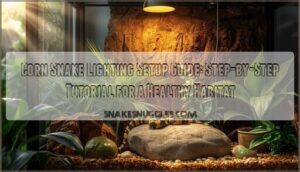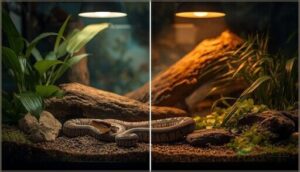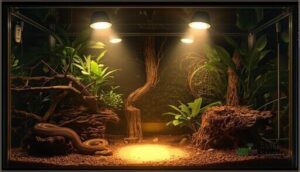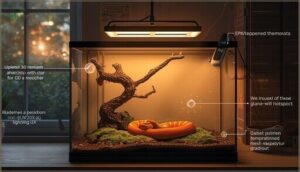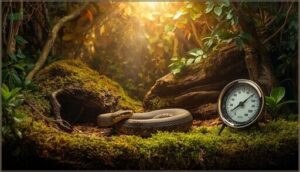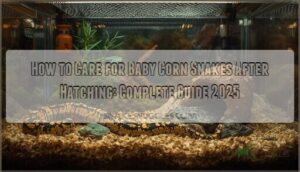This site is supported by our readers. We may earn a commission, at no cost to you, if you purchase through links.
You can keep a corn snake alive with nothing but a heat mat and room light, but you’ll never see it thrive. Most new keepers don’t realize that inadequate lighting is behind their snake’s reluctance to feed, odd sleeping patterns, and lackluster colors.
The difference between surviving and flourishing comes down to replicating the sun’s work—not just its warmth, but its spectrum and rhythm. Getting your corn snake lighting setup right means understanding three interconnected systems: UVB exposure for metabolic health, basking heat for digestion, and consistent day-night cycles for natural behavior.
The good news? Once you grasp the core principles, creating an ideal lighting environment takes less effort than you’d think.
Table Of Contents
Key Takeaways
- Proper lighting—UVB, basking heat, and consistent day-night cycles—is crucial for your corn snake’s health, behavior, and color.
- Use T5 High Output UVB bulbs, full-spectrum LEDs, and halogen basking lights, and position them to create overlapping light and heat gradients.
- Set your lights on a reliable timer to provide 12 hours on, 12 hours off, adjusting seasonally for natural rhythms and stress prevention.
- Monitor with digital thermometers and hygrometers to maintain basking temps of 88–92°F, cool zones around 75°F, and humidity between 40%–60%.
Choosing The Right Lighting Equipment
Before you bring home your corn snake, you’ll want to make sure you have the right lighting and heating gear ready. Choosing wisely is key to your snake’s comfort and long-term health.
Here’s what you need to know about the best equipment for their enclosure.
Best UVB Bulbs for Corn Snakes
The right UVB bulb makes all the difference in your corn snake’s health. You’ll want T5 High Output tubes—specifically Zoo Med Reptisun 5.0 or Arcadia Forest 6%—because they deliver consistent UVB wavelengths (290-320 nm) for proper Vitamin D3 production. It’s important to understand a corn snake’s UVB lighting needs to guarantee their well-being.
Here’s what matters most:
- Bulb lifespan: Replace annually, as output declines after 12 months
- UVI measurement: Aim for 2.0-3.0 at the basking area
- Bulb placement: Position 12-16 inches above your snake
Basking and Ambient Light Options
You’ll need two distinct lighting layers to create a proper environment. For basking, use halogen flood bulbs (50–75W) or specialized lamps that produce infrared-A power between 200–350 W/m²—these maintain a basking surface temperature of 88–90°F. Position your basking light 8–12 inches above the platform to build a focused heat gradient.
For ambient lighting, choose full-spectrum LEDs (6000–7000K) that mimic natural daylight without adding excess heat, supporting both your snake’s vision and any live plants you’ve added.
Providing proper lighting can also improve the snake’s immune system, but UVB and UVA lighting is beneficial.
Safe Heat Sources for Enclosures
Beyond lighting, you’ll need reliable heating methods to maintain that 90°F basking zone. Heat mats paired with thermostat integration remain the most popular choice—just place them under your warm hide with 2 inches of substrate buffering heat transfer.
Over tank heating via ceramic heat emitters or infrared bulbs works too, but always use a thermostat for heat mat safety and risk mitigation against burns.
Establishing a Proper Lighting Schedule
Getting your lighting schedule right is just as important as choosing the bulbs themselves. Your corn snake needs consistency to stay healthy and maintain natural behaviors.
Let’s walk through how to set up a daily routine, adjust for seasons, and use timers to keep everything running smoothly.
Recommended Day/night Cycles
Your corn snake’s lighting cycle should mirror nature’s rhythm—12 hours on, 12 hours off works perfectly for maintaining healthy circadian patterns. This day-night cycle in captivity fosters proper feeding, shedding, and overall health effects you’ll notice right away. Timer calibration offers automation benefits that simplify care:
- Juvenile schedules need 10-12 hours of consistent light for best development
- Adults thrive on standard 12/12 photoperiods year-round
- Brumation impact requires adjusted cycles if breeding
- Lighting schedule importance can’t be overstated—it prevents stress and metabolic issues
Seasonal Lighting Adjustments
Mimicking your snake’s natural environment means adjusting photoperiod manipulation throughout the year—13-hour light cycles in summer, 11 hours in winter. These seasonal lighting adjustments trigger hormonal effects that regulate activity and reproductive triggers.
Winter dormancy periods with reduced daylight cycle simulation and cooler temps support healthy circadian rhythms.
Gradually shift light cycles by 15-30 minutes every two weeks for smooth daynight cycle simulation transitions.
Using Timers for Consistency
Since manual switching invites human error, timers deliver rock-solid consistency for your corn snake’s lighting schedule. Over 67% of keepers now use programmable timers to maintain precise light cycles—and for good reason.
Digital models hold settings through power outages and support dual outlets for coordinating heat and UVB sources.
Run a 24-hour setup verification before introducing your snake, then calibrate every six months to protect that essential circadian rhythm.
Setting Up Lighting in The Enclosure
Once you’ve got the right equipment, it’s time to put everything in place. The way you position your lights directly affects your snake’s ability to regulate its temperature and absorb UVB.
Let’s walk through the setup process to help you avoid the most common mistakes that new keepers make.
Positioning UVB and Basking Lights
Think of proper lighting setup as building a miniature sun patch inside your corn snake’s home. Your goal is positioning lights so UVB and heat actually work together, not as separate systems.
- Mount your T5 HO UVB tube 30–40 cm above the basking area to hit a UVI of 2.0–3.0 (or 0.7 for albino morphs)
- Place basking lights directly above the platform, 20–30 cm high, creating overlapping beams with your UVB
- Account for mesh obstruction—screens block 30–40% of UVB, so adjust bulb distance accordingly
- Cover 1/3 to 1/2 of your enclosure’s length with UVB to establish UVI gradients throughout
- Keep climbing structures 15 cm away from bulbs to prevent accidental overexposure
Verify bulb distance with a Solarmeter 6.5 for accuracy, ensuring your thermal gradient and UVB exposure align in the basking area.
Ensuring Light and Heat Gradients
Your corn snake can’t thrive without a proper thermal gradient—it’s the foundation of thermoregulation behavior. Position heat and UVB sources at one end, leaving the opposite side cool and shaded. This creates a measurable temperature gradient your snake navigates naturally.
| Zone | Temperature Range | Purpose |
|---|---|---|
| Basking surface temperature | 90°F (32°C) | Digestion, thermoregulation |
| Ambient air temperature (warm side) | 78–82°F (25–27°C) | Active behavior zone |
| Cool zone | 75°F (24°C) | Retreat, stress reduction |
| Basking area UVI | 2.0–3.0 (0.7 for albinos) | UV standards, health benefits |
Use digital probe thermometers on surfaces and at snake height to verify your gradient. Check basking spots with a Solarmeter 6.5 for UV intensity—measurement tools prevent guesswork and support metabolic efficiency.
Avoiding Common Installation Mistakes
Common errors in lighting can undermine your entire enclosure setup. Placing bulbs closer than 20 cm risks contact burns—documented in 14% of reptile care mistakes. Glass obstruction blocks 92% of UVB rays, while mesh reduction cuts output by 30–40%.
Always use a thermostat to prevent overheating risks, maintain proper bulb distance, and position lights outside your snake’s reach to preserve your temperature gradient.
Monitoring Temperature and Humidity Levels
Once your lighting and heating are installed, you need to verify they’re actually doing their job. Your corn snake depends on precise temperature zones and consistent humidity to thrive, so guesswork won’t cut it.
Let’s look at the target ranges and the tools that’ll help you nail them every time.
Ideal Basking and Cool Zone Temperatures
You need three temperature zones in your corn snake’s enclosure. The basking spot should hit 88°F–92°F for best digestion rates—temperatures above 31°C nearly double digestive efficiency. Your cool zone sits at 75°F–82°F, while the warm side holds 80°F–85°F. This temperature gradient lets your snake thermoregulate naturally.
Nighttime drops to 65°F–72°F support healthy circadian rhythms in adults.
Humidity Range for Healthy Corn Snakes
Humidity levels between 40% and 60% keep your corn snake healthy—lower can cause shedding problems and dehydration, while higher risks respiratory infections. During sheds, boost it temporarily to 60% using a humid hide box filled with moist sphagnum moss.
Your substrate choice matters: cypress mulch and coconut fiber hold moisture better than aspen. Monitor daily with a digital hygrometer placed at both enclosure ends.
Tools for Accurate Measurement
To maintain those temperature and humidity targets, you’ll need reliable tools. Digital thermometers deliver up to 99% accuracy when probes sit in both basking and cool zones—far better than analog dials. Pair them with a digital hygrometer for humidity tracking within ±2% RH.
Infrared thermometers (temp guns) instantly check surface temps, while wireless sensors monitor gradients across larger enclosures. Calibrate every six months for consistent temperature control.
Preventing Health Issues With Proper Lighting
Getting the lighting right isn’t just about creating a pretty setup—it directly affects your corn snake’s long-term health. Poor lighting can trigger stress, disrupt natural behaviors, and even lead to serious conditions like metabolic bone disease.
Let’s look at how proper lighting protects your snake and what warning signs tell you something’s off.
Reducing Stress and Supporting Natural Behavior
When you mirror your corn snake’s natural light cycles with a consistent 12-hour schedule, you’re helping regulate its circadian rhythm and reduce stress hormones.
UVB cryptic basking opportunities—where your snake chooses its exposure—support behavioral wellness alongside proper light/heat gradients. Skip colored bulbs that disrupt vision.
Environmental enrichment strategies, including varied substrate and shaded zones, promote mental health through natural behaviors.
Preventing Metabolic Bone Disease
Beyond stress reduction, proper lighting protects your corn snake from metabolic bone disease—one of captivity’s most preventable yet common illnesses. UVB lighting drives vitamin D3 synthesis, which facilitates calcium absorption and maintains bone health. Without adequate UVB exposure, calcium metabolism falters, even with dietary balance.
Proper UVB lighting prevents metabolic bone disease by enabling vitamin D3 synthesis and calcium absorption in corn snakes
Studies show UVB setups reduce MBD incidence by over 80%, making early detection through consistent husbandry practices your best defense against skeletal issues.
Signs of Improper Lighting in Corn Snakes
When lighting goes wrong, your corn snake will show it. Lethargy signs like reduced activity and excessive hiding affect up to 65% of snakes in poor conditions. Shedding problems, feeding issues, and stress behaviors—including glass surfing—signal environmental trouble.
These behavioral changes increase illness susceptibility by nearly 70%, potentially triggering metabolic bone disease and other serious health issues if left unaddressed.
Frequently Asked Questions (FAQs)
Can corn snakes see and react to colored lights?
If a disco ball of colored lights dropped into your snake’s enclosure, you’d definitely see changes. Corn snakes have UV sensitivity and limited color perception, and improper light exposure—like red lights—can disrupt reptile behavior and cause noticeable behavioral changes.
How does lighting affect corn snake breeding cycles?
Photoperiod regulation is essential for corn snake breeding cycles. By keeping a consistent light cycle, you support healthy circadian rhythms, hormone balances, and breeding success.
Disruptions in day/night cycles or artificial lighting easily upset these sensitive processes in captivity.
What lighting adjustments are needed for juvenile snakes?
For juveniles, choose UVB intensity around UVI 2-3, keep their basking spot 88-92°F, and don’t let nighttime temperatures drop below 75°F.
Consistent cycles and proper humidity aid shedding, thermoregulation, and healthy growth.
Does lighting impact shedding frequency in corn snakes?
Think of your corn snake’s skin like a well-tuned instrument—when environmental synergy with proper UVB, photoperiod, light intensity, and humidity levels is off, shedding and skin health falter.
Shedding metrics reveal hydration management matters as much as lighting cues.
Conclusion
Sunlight’s silent symphony shapes your snake’s spirit, shifting them from surviving to shining. Secure a setup using this corn snake lighting setup guide, and you’ll witness bolder colors, active basking, and healthy appetites—echoes of a habitat in harmony.
Skip shortcuts; steady schedules and spectrum matter. Every bulb, every timer, every measured degree means your corn snake gets a life that’s closer to nature’s own rhythm. That’s the reward: not just a pet alive, but a reptile thriving.
- https://reptifiles.com/corn-snake-care-guide/corn-snake-temperatures-humidity/
- https://www.reddit.com/r/cornsnakes/comments/1izogx1/is_this_light_too_redbright_for_my_corn_snake_at/
- https://community.morphmarket.com/t/corn-snake-photoperiod/27917
- https://talis-us.com/blogs/news/optimal-basking-temperatures-for-corn-snakes
- https://www.thebiodude.com/blogs/snake-caresheets/care-guidelines-for-corn-snakes

